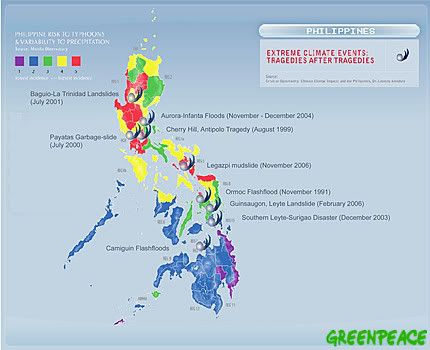Typhoon Lupit - Typhoon Ramil
Typhoon Lupit is a very large and strong storm (current maximum sustained speeds are 175 km per hour, with gusts up to 210 kph). Unfortunately, it is expected to hit Luzon on Wednesday or Thursday if the storm follows the forecast track. Given the impact of the two previous storms, the consequences are potentially grave, especially if it were to track slightly further to the south than the current forecast. Unsurprisingly, there is deep concern about this storm in the Philippines.
According to Nathaniel Cruz of the Philippine Atmospheric, Geophysical and Astronomical Services Administration (Pagasa), “The more days it spends over sea, the more it is intensifying,”. Also he said that "Ramil could turn into a supertyphoon with winds up to 215 kph and smash across Cagayan, Kalinga, Ilocos Norte, Apayao and the Batanes group of islands".
“Those in critical areas should be evacuated now that there is still time,” Pagasa chief Prisco Nilo told a news conference. “It would be more difficult to rescue people in the middle of a typhoon.”
Typhoon Lupit or Ramil strengthened to a supertyphoon east of the Philippines, where authorities are planning evacuations should the storm approach the country after the deaths of more than 770 people in cyclones since Sept. 26.
Lupit was 1,234 kilometers (767 miles) east of Palanan on Luzon island at 8 a.m. Philippines time today, according to the U.S. Navy Joint Typhoon Warning Center. The storm was moving north-northwest at 9 kilometers per hour. Lupit’s maximum sustained winds increased to 250 kph with gusts to 306 kph.
After moving slowly away from the Philippines during the past two days, Lupit or Typhoon Ramil is forecast to swing to the west and approach northern Luzon by Oct. 23, according to the Navy’s five-day forecast. It’s expected to weaken by then, with its winds forecast to decline to 222 kph.
A state of calamity remains in effect after the island was devastated by Typhoon Parma and Tropical Storm Ketsana. The government is delivering food and other relief supplies to areas that may be cut off by Lupit, Defense Secretary Gilbert Teodoro said yesterday.
Lupit is a Category 5 storm, the strongest on the Saffir- Simpson scale of cyclone strength. Such storms have winds of 250 kph or higher and are capable of causing “catastrophic damage,” according to the U.S. National Hurricane Center.
Lupit in Tagalog (Filipino language) means capable of huge and wide damage.





